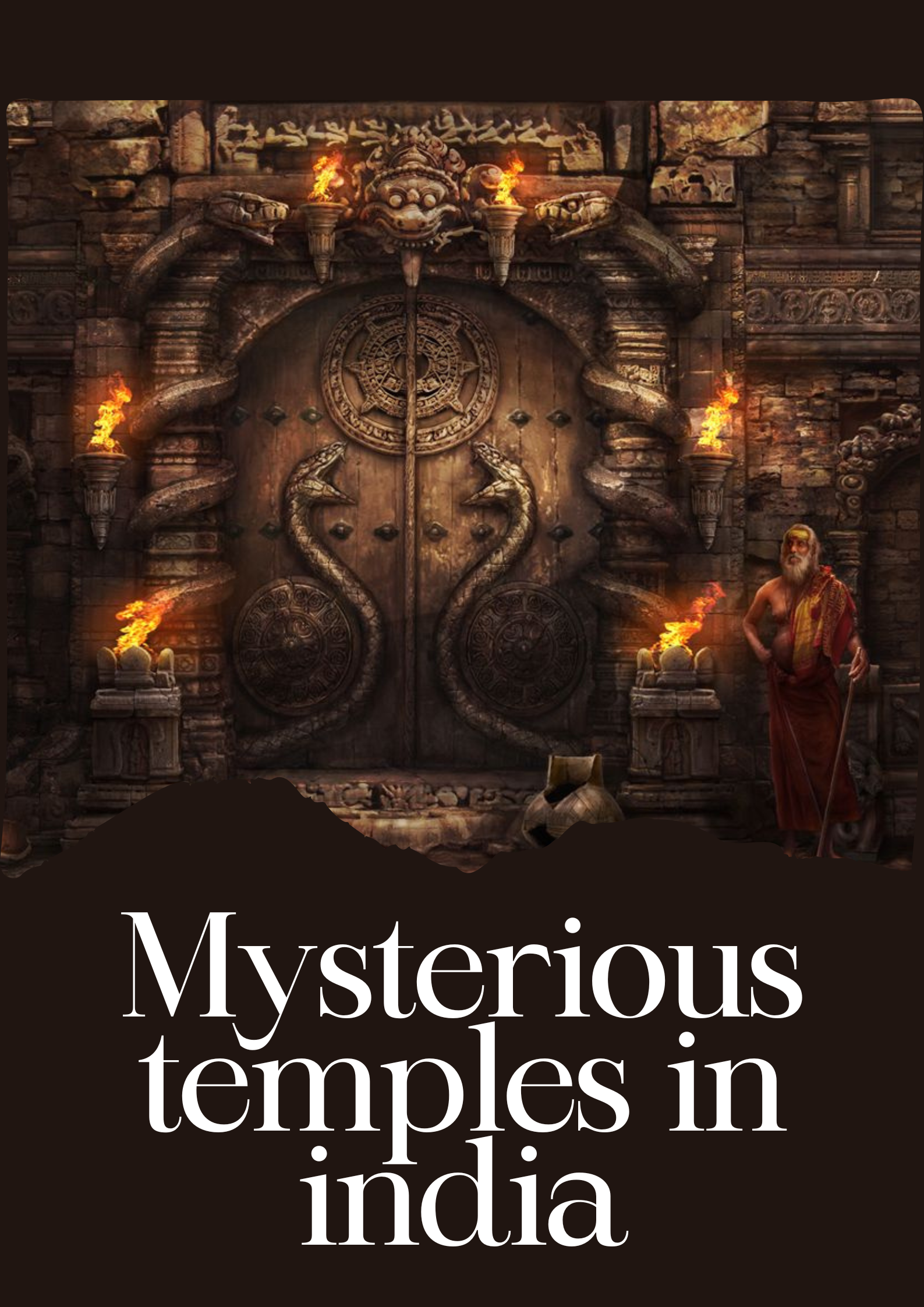You have to read to suspect the mysterious temples in India. That is more curious than the Bermuda triangle. If not, we will give your point to embrace spiritually uniquely in the most mysterious temples in India. The mystery of the abnormal temples of India will allow you goosebumps. The country, known for housing 330 million temples, is sure to surprise you with their mystery.
All temples are very mysterious and powerful temples in India. These temples have different cultures and every temple has a unique story. Every temple in the country has beautiful architecture and values. All peoples believe the temple’s culture is mysterious. Sometimes these mysteries and culture makes us fear.
Top 10 mysterious temples in India
India is home to numerous ancient temples that have stood the test of time and continue attracting visitors worldwide. Many of these temples have mysterious legends, folklore, and architectural marvels associated with them, making them fascinating to explore. Here are the top 10 mysterious temples in India.
1.Mehandipur Balaji Temple
Mehandipur Balaji Temple is one of India’s most mysterious and fascinating temples. The temple, situated in the Dausa district of Rajasthan, is famous for its distinctive rituals and the alleged ability to heal visitors miraculously. This article will explore the temple’s history, significance, traditions, and mysteries.
History
People believe that Mehandipur Balaji Temple, situated in a small village called Mehandipur, about 100 kilometres away from Rajasthan’s capital city of Jaipur, is over a thousand years old. It is an ancient Hindu temple devoted to Lord Hanuman, the monkey god.
Myths and legends steeped in history have contributed to the temple’s reputation as one of the most beautiful and enigmatic temples in India. According to local beliefs, Lord Balaji instructed a resident to construct a temple in his honour in a dream, leading to the temple’s construction. Since then, the temple has been a place of worship for people from all over India.
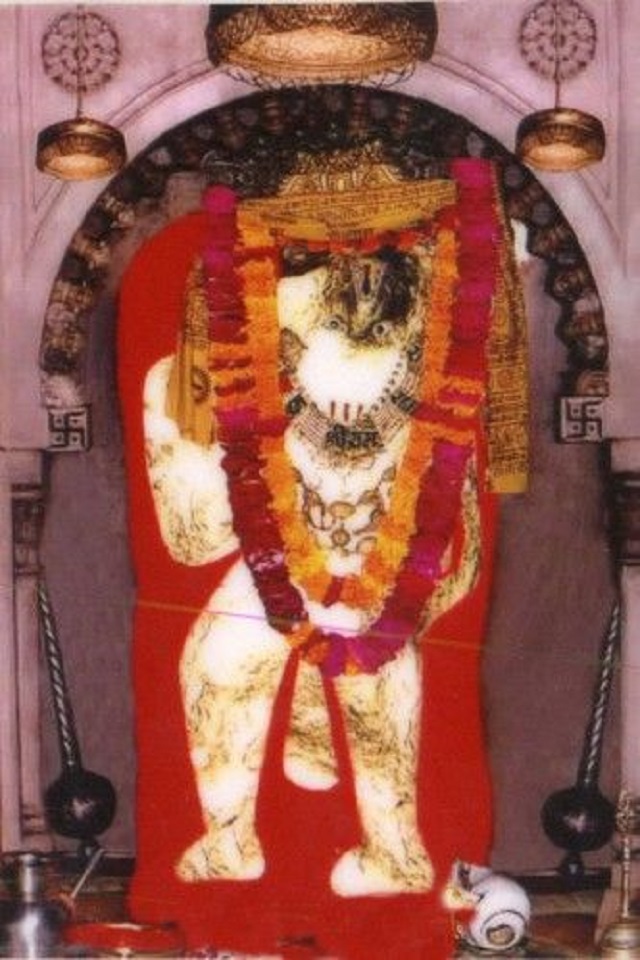
Rituals
People know the Mehandipur Balaji Temple for its daily performance of unique rituals. One of the most popular rituals is the Hanuman Chalisa recitation. Devotees believe that reciting the Hanuman Chalisa, a hymn dedicated to Lord Hanuman brings good luck and prosperity. Another popular ritual is the offering of laddoos to Lord Hanuman.
People believe that by offering laddoos to Lord Hanuman, they can fulfil their wishes and attract good luck. The temple’s reputation for performing unique exorcism rituals draws people who believe evil spirits possess them.
The priests at the temple perform these rituals to drive away the evil spirits, as they believe the temple’s energy and the blessings of Lord Hanuman are powerful enough to ward off even the most potent evil spirits.
Mystery
Several visitors have reported unexplained events and occurrences at the Mehandipur Balaji Temple, which contributes to the temple’s mysterious reputation. Many people have reported seeing apparitions and hearing strange noises inside the temple. Some have even claimed to have been physically attacked by unseen forces inside the temple.
Another mysterious aspect of the temple is the presence of thousands of nails and hair strands scattered around the temple’s premises. People believe that those who have been cured of their ailments by the unique energy and blessings of the Lord at the temple make offerings of their nails and hair strands.
2. Kamakhya Devi Temple
Kamakhya Devi Temple is one of the most significant and mysterious temples in India. It is located on Nilachal Hill in Guwahati, Assam. Goddess Kamakhya, considered the most powerful among the ten Mahavidyas, is the deity to whom the temple is dedicated.
The temple is unique in many ways, and its history and mysteries have attracted the attention of scholars, tourists, and devotees from all over the world..
The Origin of Kamakhya Devi
The origin of Kamakhya Devi Temple dates back to the prehistoric period. According to Hindu mythology, Goddess Sati, the first wife of Lord Shiva, committed self-immolation after her father, Daksha Prajapati, insulted Lord Shiva. In his grief, Lord Shiva took Sati’s dead body and started performing the Tandava dance, which is believed to be the dance of destruction.
To stop the destruction, Lord Vishnu used his Sudarshan Chakra and cut the body of Sati into 51 pieces. The places where the body parts fell became the Shakti Peethas, and where the yoni (vagina) of Sati fell became the Kamakhya Devi Temple.
Mystery of Bleeding Goddess
One of the most significant mysteries of Kamakhya Devi Temple is the bleeding of the goddess during the annual Ambubachi Mela. The Ambubachi Mela is celebrated in June every year, during which the temple remains closed for three days. It is believed that during this time, the goddess menstruates, and the water of the Brahmaputra River turns red.
Altogether The bleeding of the goddess is considered auspicious, and devotees from all over the world come to witness it. Many scientists and researchers have tried to find the reason behind the bleeding, but so far, no one has solved the mystery.
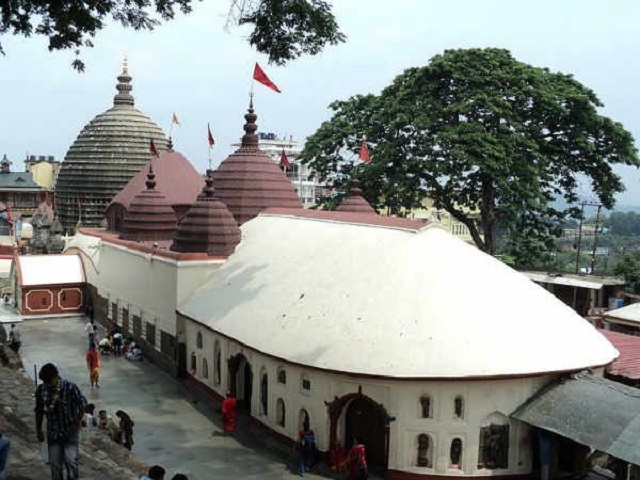
History
Especially Kamakhya Devi Temple has a long and rich history. It is believed that the temple was destroyed many times and rebuilt by different kings and rulers. The temple was first mentioned in the Kalika Purana, written in the 8th century. Another The Koch king, Naranarayan, rebuilt the temple in the 17th century.
Later, the temple was renovated and expanded by King Rajeswar Singha of the Ahom dynasty in the 18th century. During British rule, the temple was neglected and was in a dilapidated condition. The Assam government later restored it.
3. Sri Tirupati Balaji Temple
Sri Balaji temple is one of the most mysterious temples in India, and Located in the southeastern part of Andhra Pradesh, Sri Tirupati Balaji Swamy Temple is a famous Hindu temple dedicated to Lord Venkateswara. This temple, situated on the seventh peak of Tirumala Hills, attracts millions of devotees worldwide.
History
The history of Sri Tirupati Balaji Swamy Temple dates back to the ancient times when Lord Vishnu took the form of Lord Venkateswara to save mankind from the atrocities of the demon king, Kali. According to the legend, the temple was built by the Pallava king, Thondaiman, in the 9th century AD. Later, various dynasties like Chola, Pandya, and Vijayanagara expanded and renovated the temple.
The temple gained popularity during the reign of the Vijayanagara Empire, which ruled from the 14th to the 17th century AD. The emperors of the Vijayanagara Empire were ardent devotees of Lord Venkateswara, and they contributed significantly to the development of the temple.

Mystery
The Sri Tirupati Balaji Swamy Temple is shrouded in mystery, and several legends are associated with it. One of the most popular legends is that the temple is the richest in the world. It is believed that the temple receives around 60,000 to 80,000 devotees daily, and the daily collection from the temple is around 22 million rupees.
Another mystery associated with the temple is the hair donation ritual. It is a common practice among devotees to shave their heads as a mark of respect and gratitude to the deity. The temple authorities collect the hair and sell it to wig manufacturers. It is said that the temple earns around 200 crores annually from this hair donation ritual.
In this temple, the idol is located in the right-hand corner of the Garbhagudi but appears in the middle of the holi place.
After the morning, Abhishekam. The sweat is wiped with a silk cloth. Tirupati Balaji imprisoned the history of being the liberal and the must-see temple in India.
The main idol of Balaji is alive, and people trust it because when you place your ear on the black of the main idol, you can hear the second of a roaring ocean.
4. Sri Anantha Padmanabha Swamy Temple
The Sri Anantha Padmanabha Swamy Temple has a long and rich history that dates back to the 8th century. According to legend, the temple was built by the ruler of the Chera dynasty, King Marthanda Varma. The temple was built on land reclaimed from the sea and was dedicated to Lord Vishnu in his Anantha Padmanabha form.
Various rulers, including the Travancore kings, expanded and renovated the temple over the years. The Travancore Royal Family now maintains the temple, and the Maharaja of Travancore serves as the temple’s trustee.
Architecture
Sri Anantha Padmanabha Swamy temple is One of the most mysterious temples in India. The Sri Anantha Padmanabha Swamy Temple is known for its magnificent architecture, a prime example of Dravidian-style temple architecture.
The temple’s main sanctum sanctorum, is located in the innermost chamber and is accessible through three doors. The chamber is built in a way that allows the sun’s rays to fall on the deity during certain times of the year.
The temple’s outer walls are adorned with intricate carvings and sculptures of gods and goddesses. The temple’s gopuram (tower) is 100 feet tall and is a prominent feature of the temple’s skyline. The temple also has a mandapam (hall) with 365 and a quarter sculpted granite stone pillars, each unique design.

Mystery
The Sri Anantha Padmanabha Swamy Temple is mysterious due to its hidden vaults and chambers. The temple has six vaults labeled A to F, with vault B being the most mysterious. The vaults are believed to contain vast treasures, including gold, diamonds, and precious stones.
In 2011, vault B was opened for the first time in over 130 years, and it was found to contain a vast treasure trove worth over 1 trillion rupees (approximately 20 billion USD). The discovery of the treasure sparked controversy, and many believe there are still more vaults and chambers yet to be opened.
5. Lepakshi Temple
Lepakshi Temple is a fascinating architectural wonder located in the Anantapur district of Andhra Pradesh, India. It is one of the finest examples of the Vijayanagara style of architecture and is renowned for its exquisite carvings and sculptures.
However, Lepakshi Temple is not just known for its beauty but also for the many mysteries and legends that surround it. Lepakshi Temple is one of the most Mysterious temples in India.
History
Lepakshi Temple was built during the reign of the Vijayanagara Empire in the 16th century. The temple was built by two brothers, Virupanna and Viranna, who were treasurers in the court of King Achutaraya. According to legend, Virupanna was accused of embezzlement of funds and was punished by having his eyes gouged out.
It is said that he then cursed the temple and left it unfinished. Altogether It is why one of the pillars in the temple is said to be hanging in mid-air, defying gravity.
The temple is dedicated to Lord Shiva and Lord Vishnu. The main deity is Lord Veerabhadra, a fierce form of Lord Shiva. The temple is adorned with beautiful sculptures of Lord Vishnu, Lord Ganesha, and Goddess Durga, among others.

Mystery
Basically Lepakshi Temple is shrouded in mysteries and legends, adding charm and allure. Another One of the most famous mysteries of Lepakshi Temple is the hanging pillar. This pillar is said to be hanging in mid-air and is not in contact with the ground. The pillar is also said to be able to rotate on its axis.
Another mystery of Lepakshi Temple is the presence of a footprint on one of the pillars in the temple. According to legend, the footprint belongs to Lord Hanuman, who visited the temple during its construction and left his mark on the pillar.
There is also a painting in the temple depicting Lord Krishna’s birth. Interestingly, this painting shows Lord Krishna being born with a mustache, which is not a common depiction of the deity.
6.Meenakshi Amman Temple
Meenakshi Amman Temple is a historical and architectural wonder located in Madurai, Tamil Nadu, India. It is one of India’s oldest and most significant temples, dedicated to Goddess Meenakshi, an avatar of Goddess Parvati, and Lord Sundareswarar, an avatar of Lord Shiva.
The temple complex spans over 14 acres and comprises four main entrances, numerous mandapams, and towering gopurams adorned with intricate sculptures and carvings. The temple attracts millions of devotees and tourists annually, making it a must-visit destination in South India.
History
The Meenakshi Amman Temple has a rich and fascinating history that spans thousands of years. According to legend, the temple was built by the Pandyan king, Kulasekara Pandya, in the 6th century AD. However, the temple’s current structure was constructed during the Nayak period in the 16th century by King Viswanatha Nayak and his successors.
The renowned architect Vishwanatha Nayak designed the temple and combined the Dravidian and Islamic styles of architecture to create a unique and awe-inspiring structure. The temple has undergone numerous renovations and additions over the years, with each ruler adding unique touches to the temple complex.
The temple was also plundered by various invaders, including Malik Kafur, who looted the temple in the 14th century and took the temple’s idol with him to Delhi. The Vijayanagara emperor Krishna Deva Raya later recovered the idol and returned to the temple.

Mystery
Therefore One of the most intriguing mysteries surrounding the Meenakshi Amman Temple is the story of the sacred pond known as the Golden Lotus Tank. particularly According to legend, the tank was created by the gods, filled with the holy waters of the Ganges, Yamuna, and Saraswati rivers. The tank is said to have healing powers, and it is believed that taking a dip in the tank can cure various ailments.
However, the mystery surrounding the tank is not related to its miraculous healing powers but rather its construction. The tank has two layers of brickwork, with an intermediate layer of sand, and it has never been known to leak or crack.
What makes this even more remarkable is that the tank was built in an area with high seismic activity. Yet, it has withstood numerous earthquakes over the centuries without sustaining any damage.
Another mystery surrounding the temple is that it is built in the shape of a Sri Chakra, a sacred geometric pattern used in Hindu worship. The temple’s design is so precise that the Chakra can be seen from a bird’s eye view. The temple’s architects must have possessed incredible knowledge and skill to create such a complex and precise structure
7.Kailasa Temple
Kailasa Temple is a remarkable ancient temple located in the western state of Maharashtra, India. This magnificent temple is one of the most remarkable creations of ancient Indian architecture. It is known for its unique rock-cut architecture, an extraordinary example of ancient Indian rock-cut architecture. It is believed that the temple was built during the Rashtrakuta dynasty, around the 8th century AD, by King Krishna I.
Mystery
The Kailasa Temple has always been shrouded in mystery and intrigue. One of the greatest mysteries of this temple is how it was constructed. The entire temple was carved out of a single piece of rock, and it is estimated that more than 200,000 tons of rock were excavated to create this masterpiece.
It is believed that the temple was constructed using chisels and hammers, which is a remarkable feat considering the lack of modern technology during that time.
Another mystery surrounding the Kailasa Temple is its purpose. While it is known to be a Hindu temple dedicated to Lord Shiva, many historians and researchers believe it may have served a more significant purpose. Some have suggested that the temple was not only a place of worship but also a center of learning, a hospital, and even a laboratory for alchemists.

History
King Krishna ruled the Rashtrakuta dynasty from 756 to 773 AD and oversaw the construction of the Kailasa Temple. The Rashtrakutas were a powerful dynasty that ruled over vast areas of South India during the medieval period and was known for their support of art and architecture.
Lord Shiva, one of the most revered deities in the Hindu pantheon, is the focus of the Kailasa Temple. The temple complex spans an area of 2.4 hectares and includes several structures, such as a main temple, a Nandi mandapa, and two other small temples.
The temple’s exquisite carvings and intricate sculptures depict various scenes from Hindu mythology, and the central shrine, standing 30 meters tall, is carved out of a single piece of rock, making it a remarkable feature. The intricate carvings and sculptures of the temple showcase the skill and artistry of ancient Indian artisans.
8.Stambheshwar Mahadev Temple
Stambheshwar Mahadev Temple is one of the most mysterious temples in India. Eventually Unique Hindu Stambheshwar temple located in the Kavi Kamboi in Gujarat, India. The temple is situated on an island in the Narmada River, surrounded by water during high tide. Basically It is dedicated to Lord Shiva and attracts thousands of devotees yearly.
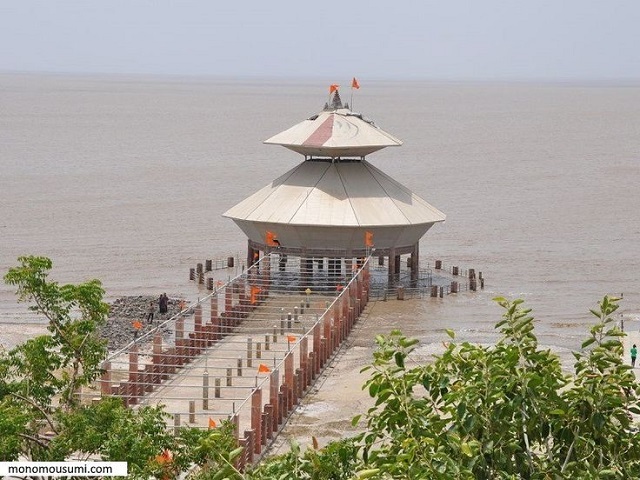
History
The exact history of the Stambheshwar Mahadev Temple is still being determined. However, it is believed that the temple was built during the reign of the Solanki dynasty. The Solanki dynasty ruled Gujarat from the 10th to the 13th century.
The temple is mentioned in the Skanda Purana, one of the eighteen Mahapuranas of Hinduism. According to the Skanda Purana, the temple is one of India’s most sacred Shiva temples.
The temple has undergone several restoration over the years. The current temple structure was built in the 1960s. The temple is a beautiful example of traditional Hindu temple architecture, and it is a popular tourist attraction in Gujarat.
Mystery
Especially The mystery of Stambheshwar Mahadev Temple makes it a unique destination for visitors. The temple is situated on an island in the Narmada River However, a secret path appears during low tide, allowing visitors to walk to the temple. This path is said to have been built by Lord Shiva himself.
The temple’s mystery lies in the fact that no one knows how the path was constructed. The path is not visible during high tide and is not affected by the river’s strong currents. The path is said to have been built using a unique technique lost to time.
Another mystery associated with the temple is that of the lingam, which represents Lord Shiva. Especially Temple is said to be self-manifested, meaning it appeared on its own without any human intervention. It is a rare occurrence in Hindu mythology and adds to the temple’s mystery.
9.Kalbhairavnath temple
Kalbhairavnath temple is one of the most mysterious temples in India. People offer sweets and hot food as prasad in most temples, but the temple in Madhya Pradesh provides liquor as prasad. Ujjain is the Kalbhairavnath temple which is the image of lord shiva. The offerings made to the god here, including the prasad, are all prepared with alcohol such as whiskey or wine.
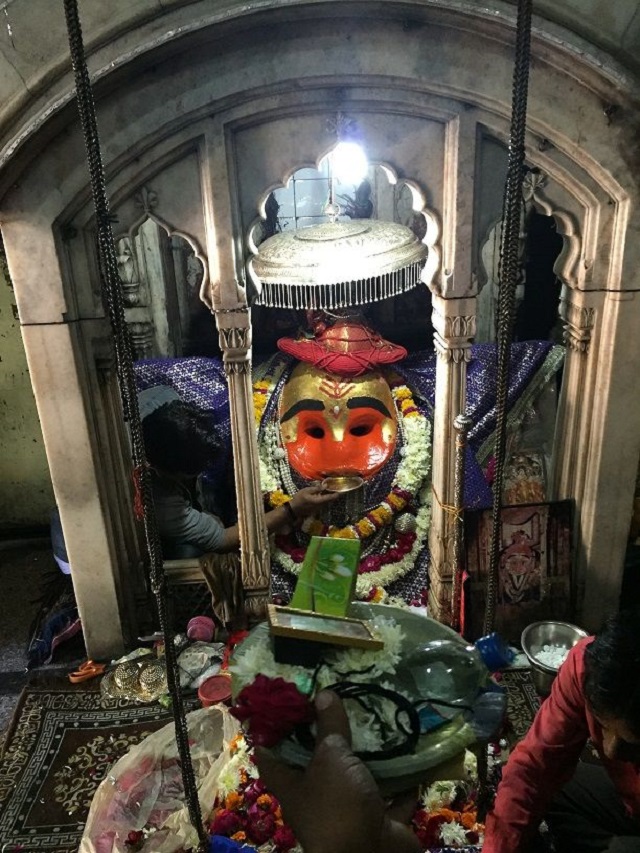
The devotees generally offer sweets to Kalbhairav, but in this temple, alcohol is poured into his mouth, and sweets are sold in the nearby shops. Also Here, no matter what shop you go to, they sell alcohol.
10.Bullet Baba Temple
The Bullet Baba Temple is one of India’s most mysterious temples and intriguing religious sites. The shrine dedicated to the motorcycle deity known as Om Banna or Bullet Baba is located near Pali in the state of Rajasthan. At the same time The temple has a fascinating history and a series of unexplained phenomena that have baffled visitors for decades.
Especially This article will explore the mystery and history of the Bullet Baba Temple and provide a comprehensive guide to everything you need to know about this unique site.
History
Legend has it that after a young man named Om Banna died in a motorcycle accident near the Bullet Baba Temple in 1991, his spirit possessed the motorcycle, making him a protective deity for the area. The motorcycle would mysteriously reappear at the accident site whenever someone tried to move it.
People built a shrine at the accident site in honor of Om Banna, and they glorified his motorcycle in a glass case. The shrine quickly gained popularity, and people from all over India began to make pilgrimages to the site to seek the blessing of the Bullet Baba.
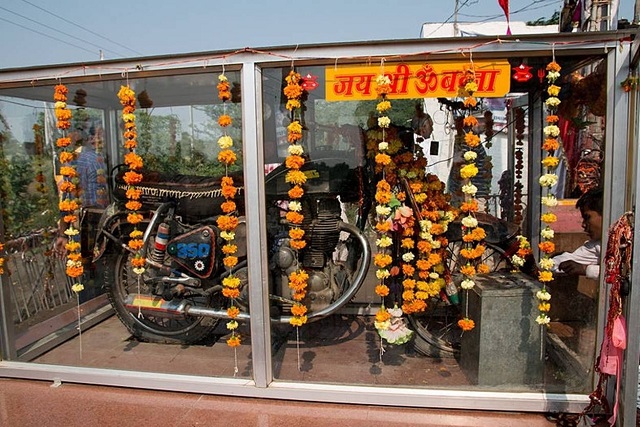
Mysterious events of bullet baba
Over the years, the Bullet Baba Temple has become famous for a series of unexplained phenomena. One of the most well-known is the inexplicable movement of the motorcycle. Despite being firmly bolted to the ground, the motorcycle can move independently, and sometimes it even changes positions overnight.
Some people believe that the movement of the motorcycle is a sign that the Bullet Baba is alive and well and is still protecting the area. Another unexplained phenomenon is the appearance of greasy handprints on the motorcycle. The handprints have been known to appear overnight despite the motorcycle being kept locked in a glass.
Some people believe that the handprints are a sign that the Bullet Baba is still actively protecting the area and that he is leaving his mark on the motorcycle to show that he is still present.
Conclusion
In conclusion, each of these temples has a unique history and mystery that continues to fascinate and intrigue people worldwide. Each temple has its significance while allure, from the healing powers of the Mehandipur Balaji Temple to the mystical stories of the Kamakhya Devi Temple.
Additionally the Lepakshi Temple and Meenakshi Amman Temple are famous for their beautiful sculptures and detailed carvings. all temples most precious and mysterious temples in India. Overall, these temples are not just places of worship but also symbols of India’s rich cultural heritage and legacy. For more articles click here 21 hashtags
